

 The South African
The South African
Major Darrell D. Hall
INTRODUCTION
The first breech-loading field gun to be used by the Royal Artillery was the Armstrong 12 pr Rifled Breech Loader (RBL). Batteries received it in the early 1860s. This is an account of the field guns in use with the Royal Artillery from that day to this. The subject is large, and only a brief account of 100 years of development can be given.
This article will be confined to the main weapons of this period -- those with which Gunner batteries were actually equipped. It will concentrate on field artillery, not horse artillery, except where the equipment of this branch is relevant to the story. In addition, only towed artillery will be dealt with - not the self-propelled guns with which the Gunners were equipped towards the end of the period under review.
The story will be told in three parts:
Part I .. .. 1860-1900
Part II .. .. 1900-1914
Part III .. .. 1914-1960
PART I
1860-1900
For centuries before the Crimean War, British artillery had been equipped with cast-iron or bronze smooth bore,
muzzle-loading ordnance. During that war experiments were carried out with 68 prs and 8-inch guns converted into
rifled ordnance on the Lancaster principle. In this system, the bore was in a twisted or spiral ellipse, and was oval in
section. It was not a success.
Then in 1859-60 came the greatest step in progress to occur throughout the whole course of the Royal Artillery's existence. Wrought iron, built-up, rifled breech-loading ordnance were adopted for the first time. (The term 'built-up' means the construction of the gun barrel by shrinking wrought iron coils on to an inner tube).
The genius behind this step was a Mr W. G Armstrong, a Tyneside engineer. His principles were applied to several calibres, but in field artillery they resulted in the 12 pr Rifled Breech Loading (RBL) Armstrong gun.
This gun was used in China in 1860 and New Zealand in 1863. It saw service in South Africa, and was used to fire the salute at Cetewayo's coronation in 1873. One now stands in the Old Fort in Durban, and another is outside a MOTH Hall in East London.
In these early days, the greatest problem was how to close the breech. In the Armstrong this was achieved by dropping a block of wrought iron into an opening at the breech end of the gun. This was called the vent-piece, as it incorporated the vent used in firing the gun. The vent-piece weighed 15 lbs for the 12 pr, and more for the larger guns. For the latter, the excessive weight proved to be unacceptable, so a side closing device was adopted for them.
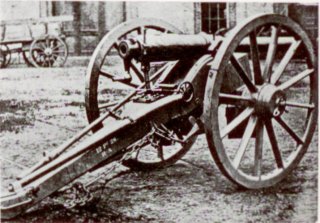
Armstrong 12 pr 8 cwt RBL -
This shows the lever for tightening
the breech screw,
which is hollow
to allow for
loading from the rear.
The carriage is wooden.
The 12 pr's vent-piece was pressed home against the chamber by screwing in a breech screw. This was hollow to allow for the loading of the gun from the rear.
The projectile was coated with lead making it slightly larger than the bore of the gun. On discharge, the soft coating was compressed into the many grooves of the rifling, giving it a rotatory motion. This gave better ballistics and a greater range.
A tangent sight was also adopted for the Armstrong RBL. This system was used until the end of the century. The carriage was wooden: and an advantage the gun had over the smooth bore was that it was much lighter. A 12 pr SB weighed 18 cwt and a 12 pr RBL only 8 cwt.
At this time, another inventor, Mr. J . Whitworth, introduced a similar RBL. This was not so successful. With his gun, the breech screw had to be removed before loading.
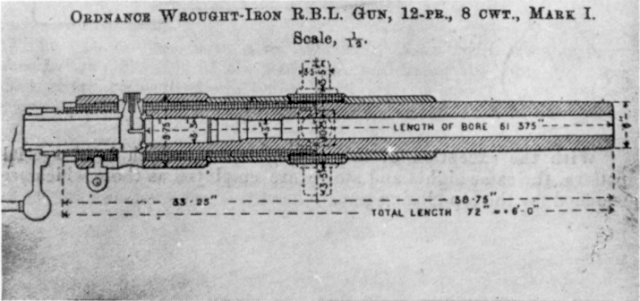
Armstrong 12 pr 8 cwt RBL -
Just forward of the hollow breech screw
is the vent-piece, incorporating a right-angled vent.
The rifling was similar to the Lancaster system mentioned earlier, and the bore was hexagonal. The Whitworth gun did not come up to expectations, and it never became part of the British armament.
British Armstrong and Whitworth guns were used in the American Civil War -- both with some success. In spite of this, a movement now grew for a return to muzzle-loading. This was largely because construction methods were not keeping pace with the advances being made by scientists and inventors. There were several accidents because of mechanical weaknesses.
An 1865 committee reported that "the breech-loading guns are far inferior to muzzle-loading as regards simplicity of construction and cannot be compared to them in this respect in efficiency for active service." This report established the principle that heavier natures should be muzzle-loading with three rifling grooves only (the Woolwich system) -- a marked departure from the Armstrong poly-groove system.
This view found favour with one veteran who said: "First of all they insisted on having a lot of grooves in the bore of the gun. Now they are only going to have three grooves in the bore of the gun. Please goodness they will next have no grooves at all, and we shall get back to the good old smooth bores which did all that was necessary to beat the Russians and smash the Mutiny."
A rifled gun was more accurate, but another veteran declared that this was no advantage. On being told that shot from a rifled gun would fall into a much smaller area than that from a smooth bore, he replied that this proved the superiority of the smooth bore. "With your new-fangled gun firing at me, I have only to keep outside that small area and I shan't be touched. But with a smooth bore firing at me, I'm not safe anywhere!"
Tests were conducted and it was found that muzzle-loaders held their own in range and rapidity of fire, were sufficiently accurate and, most important were much more simple and far less costly. So the change was made, but to Rifled Muzzle Loaders (RMLs), not to smooth bores.
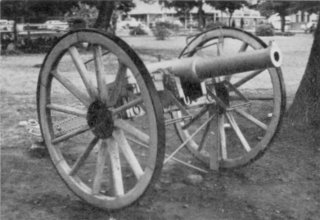
9 pr 8 cwt RML
In 1869, a 9 pr RML of bronze was adopted for India. Two years later a 9 pr RML of 8 cwt was introduced for field artillery. This was sighted to 3500 yds - about the same range as that of the Armstrong RBL. A 9 pr of 6 cwt was adopted for horse artillery. The 8 cwt gun was later dropped when the effectiveness of the 6 cwt gun was appreciated.
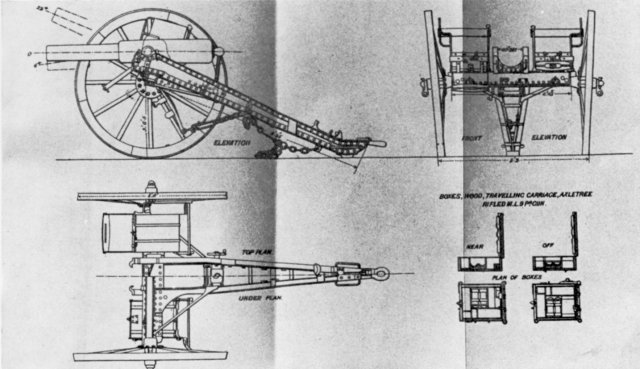
9 pr 8 cwt RML - These diagrams
show the simplicity of the 9 pr carriage.
Throughout this time, a watch was kept on continental developments. When news came that 200 Krupp breech-loaders had failed during the Franco-Prussian War, it was felt that the change had been justified.
Later a 16 pr was introduced for field artillery when a decision was made to provide a heavier shell. This gun did not replace the 9 pr -- both remained in service as light and heavy field artillery. The 16 pr was sighted up to 4000 yds.
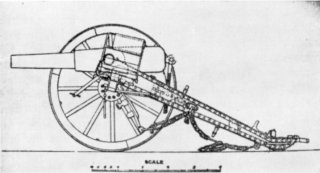
16 pr 12 cwt RML - The equipment
of heavy field artillery.
With a weight behind the gun team of 35 cwt, the 9 pr had been too heavy for use in roadless country. Consequently a special 'Kaffraria pattern' field carriage was designed for use with the 7 pr RML mountain gun. The weight behind the team in this case was only 25 cwt. This was the main equipment used by the Royal Artillery in the successive South African campaigns between 1875 and 1880. Two of these guns can be seen in Kokstad today.
A slower burning powder was then used to achieve greater muzzle velocity for the heavier elongated projectiles then in use. This produced a demand for a longer barrel as the propellant was not being fully burnt before the shell had left the barrel. At that time also, gas checks were introduced to eliminate windage which caused considerable erosion in the bore. These gas checks developed into the copper driving bands used to this day, giving the shell rotation, increasing efficiency and producing a return to polygroove rifling.
In 1878, it was decided that the 9 pr and 16 pr were out of date, so a 13 pr RML was designed for both horse and field. This gun had a longer barrel; a steel carriage; an elevating arc in place of the elevating screw; and axletree seats, so that two men could remain with the Number One and, if necessary, work the gun alone while waiting for the detachment. (Axletree seats had also been provided for the 9 pr and 16 pr).
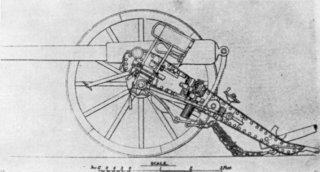
13 pr 8 cwt RML - The long barrel
and the elevating arc are prominent.
The 13 pr RML was used in Egypt in 1882, but it was not very popular. It was accurate and had a range of 4800 yds, but it had a violent recoil. 16 prs were also used there. With a weight behind the team of 43 cwt, they gave much trouble in the soft sands of the desert.
Meanwhile developments in England were continuing, and before rearmament with the 13 pr RML was complete, a new gun had appeared. This was the 12 pr 7 cwt, and it was breech-loading. The experts had decided that, after all, muzzle-loading was obsolete. By 1885, both RHA and RFA had been re-equipped.
Remembering the violent action of the 13 pr, much thought was given to controlling recoil. This problem had become more urgent with the improved and more powerful propellants then in use. For example, the muzzle velocity of the 13 pr RML was 1595 ft/sec; that of the 12 pr 7 cwt BL was 1710 ft/sec.
In the 12 pr 7 cwt, the axletree was connected to the trail on each side by stays in which were strong spiral springs. The axletree itself had a small amount of play in its seating, with a view to easing the initial recoil stresses taken by the spring stays. The recoil was also checked by brakes on the hubs of the wheels. These were held by a pawl and ratchet, so that they acted during recoil only, and did not prevent running up after firing. On the move, they could be operated from the axletree seats. In some cases, drag shoes were also used to help limit recoil.
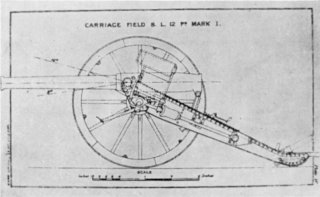
12 pr 7 cwt BL - This gun
marks the return
to breech-loading, and is the direct
forerunner of the Boer War 15 pr.
The elevating gear was improved. A toothed arc operated through a worm and arc pinion, these being connected by a friction cone which slipped on firing, thus easing the blow on the teeth of the arc and pinion. With some Marks, a limited traverse of four degrees was incorporated.
Sighting was also improved, and this was the first equipment to be supplied with a telescopic sight in addition to the usual tangent scale and foresight.
Problems arose when the 12 pr 7 cwt was used in the great Indian cavalry manoeuvres of 1891. The carriage was found to be much too complicated. The axle traversing device, in particular, gave trouble as the dust caused the metal surfaces to seize. In addition, with a weight behind the team of 37 cwt, it was found to be too heavy for RHA.
A new 12 pr 6 cwt with a lighter and simpler carriage was consequently introduced for horse artillery, at 33 cwt behind the gun team. At the same time, experience was showing that the common shell of the 12 pr 7 cwt had little or no effect on earthworks, and it was thought that a field gun ought to fire a shell heavier than 12 lbs.
A committee assembled in 1892 to consider this question shortly after cordite had been adopted. This new smokeless propellant was much more powerful than gunpowder and provided an opportunity for adding to the weight of the shell, without such increase demanding any very important alterations in the actual gun.
The committee, therefore, recommended that the 12 pr 7 cwt should be converted into what was designated a 15 pr, although it actually fired a 14 lb 1 oz shell. Field artillery were issued with the converted gun, with shrapnel as its only shell. Common shell on the battlefield would come from the 5 in. howitzers of the RFA.
Although the 15 pr had a percussion range of 5600 yds, its effective range was only 4100 yds because of limitations in the time fuze. This was the maximum shrapnel range. Similarly the 12 pr 6 cwt had an effective shrapnel range of only 3700 yds. During the Boer War an improved time fuze was introduced. This increased the 15 pr's shrapnel range from 4100 yds to 5900 yds, and the 12 pr's correspondingly.
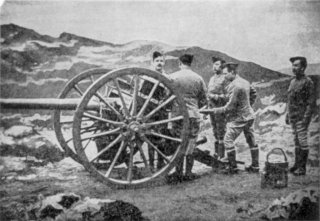
15 pr 7 cwt BL - This is
the Mk 1 carriage, i.e. the original carriage
fitted with the axle spade and trail spring.
AUTHOR's NOTE: from Vol 2 no 5
Refer Part I, l860-l900 published in Vol. 2, No. 4, December, 1972, page
144:
The caption to the photograph of 15 pr 7 cwt BL is incorrect. It should
read: Mk 1* carriage
It will be recalled that the 7 pr RML had been given the 'Kaffraria carriage' for use in South Africa. The 2,5 in RML 'Screw gun' had replaced the 7 pr, and thought was given to adapting this for mobile use in this country. It was given a special limber and, mounted on its usual carriage, trials were carried out with the gun being drawn by a pair of cobs abreast, with pole and breast harness, and driver mounted.
Officers, Numbers One, trumpeters, etc., were mounted, but the detachments had to walk. It was found that the gun was prone to capsize, but it was easily turned right side up again, and no harm was done. The battery did not possess the mobility of a normal field battery, nor of a pack battery armed with the same gun in difficult terrain. Short trots were indulged in when coming into action, with the detachment doubling behind. The comments of the detachment can be imagined! The experiment was not a success.
Later the 2,5 in. RML was given a field carriage, and it was used in South Africa. Some local units were in action with this equipment in 1899, and examples are to be found at Fort Klapperkop near Pretoria. It was not widely used during the war, as it was completely outclassed by Boer artillery. (Photographs of both 7 pr and 2,5 in. RML on field carriages can be found in 'Guns in South Africa' in Vol.2, No 1 of the Military History Journal).
To return to the 15 pr -- this gun retained the main features of the 12 pr 7 cwt's recoil system. Elevation saw a return to the elevating screw system. Later a 15 pr carriage with a buffer recoil system was introduced. This only allowed a short recoil of four inches, and did little to relieve the problem.
Then came the idea of the axle spade. This spade was connected to a spring in the trail, and so limited the rearward movement of the complete gun and carriage when the gun was fired, but it resulted in a considerable jump. Most guns used in the South African War had these spades.
Several Marks of 15 pr followed. The hydraulic buffer was discarded, and improvements were made to the strength of the carriage and to the brakes. The authorities adhered to the 'one shell, one fuze' principle, and for some time to come, the British Army's field gun had only the shrapnel shell. The 5 in. howitzer, adopted in 1896, provided the high explosive aspect, and it was on this principle that it had been introduced. Operations in South Africa were beginning to show that this was not a wise decision.
This account has already illustrated that no gun lasted long at this time of continuing development. It was then found that the continental weapons being used by the Boers were superior to those of Britain's field artillery. Comparatively, the 15 pr had a slow rate of firing, a poor recoil system, a light shell and a short range.
Part II which will appear in the next issue of this journal will describe the action taken to rectify this situation.
REFERENCES
History of the Royal Artillery - Headlam
Modern Guns and Gunnery 1910 - Bethell.
Artillery Through the Ages - Rogers.
Proceedings of the Royal Artillery Institution, Vols XXVIII and XXIX.
The Story of the Gun - Wilson
The Gunner Magazine - Our Guns: The 18 pr QF Gun.
Artillery: Its Origin, Heyday and Decline - Hogg.
| Type | Weight of gun | Calibre | Weight of shell | Ammo. | MV (ft/sec) | Range (yds) | Weight behind team(cwt) | Year adopted | |
|---|---|---|---|---|---|---|---|---|---|
| Armstrong 12 pr | RBL | 8 cwt | 3 in | 10 lb 11 oz 11 lb 4 oz 10lb 9oz 11lb 8oz | Shrapnel Common Segment Case | 1239 | 3400 | 37 | 1860 |
| 9 pr | RML | 8 cwt | 3 in | 9 lb 13 oz 9 lb 1 oz 9 lb 10 oz | Shrapnel Common Case | 1330 | 3500 | 35 | 1871 |
| 9 pr | RML | 6 cwt | 3 in | 9 lb 13 oz 9 lb 1 oz 9 lb 10 oz | Shrapnel Common Case | 1234 | 3300 | - | 1871 |
| 16 pr | RML | 12 cwt | 3.6 in | 17 lb 14.5 oz 16lb 1.5oz 15lb 3oz | Shrapnel Common Case | 1310 | 4000 | 43 | 1871 |
| 7pr | RML | 200lb | 3in | 7lb 11oz 7lb 4 oz 12lb 4 oz | Shrapnel Common Double | 968 | 3000 | 25 | 1875 |
| 13 pr | RML | 8 cwt | 3 in | 13 lb 10.5 oz 13 lb 13 lb 7.5 oz | Shrapnel Common Case | 1595 | 4800 | 39 | 1878 |
| 12 pr | BL | 7 cwt | 3 in | 12 lb 8 oz | Shrapnel Common | 1710 | 5000 | 37 | 1883 |
| 15 pr | BL | 7 cwt | 3 in | 14 lb 1 oz | Shrapnel | 1574 | 4100 | 37 | 1895 |
| 2.5 in | RML | 400 lb | 2.5 in | 7lb 6oz 8 lb 2oz | Shrapnel Ring Star Case | 1440 | 3300 | - | - |
Return to Journal Index OR Society's Home page
South African Military History Society / scribe@samilitaryhistory.org